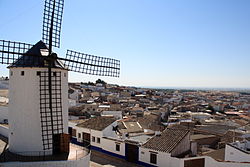Campo de Criptana
| Campo de Criptana | |||
|---|---|---|---|
| Municipality | |||

Campo de Criptana
|
|||
|
|||
| Location in Spain | |||
| Coordinates: 39°24′N 3°7′W / 39.400°N 3.117°WCoordinates: 39°24′N 3°7′W / 39.400°N 3.117°W | |||
| Country |
|
||
| Autonomous community | Castile-La Mancha | ||
| Province | Ciudad Real | ||
| Comarca | Mancha Alta | ||
| Judicial district | Alcázar de San Juan | ||
| Commonwealth | Promancha | ||
| Government | |||
| • Alcalde | Santiago Lucas-Torres López-Casero (2007) (PP) | ||
| Area | |||
| • Total | 302.41 km2 (116.76 sq mi) | ||
| Elevation | 707 m (2,320 ft) | ||
| Highest elevation | 780 m (2,560 ft) | ||
| Lowest elevation | 635 m (2,083 ft) | ||
| Population (2008) | |||
| • Total | 14,870 | ||
| • Density | 49/km2 (130/sq mi) | ||
| Demonym(s) | criptanense | ||
| Time zone | CET (UTC+1) | ||
| • Summer (DST) | CEST (UTC+2) | ||
| Postal code | 13610 | ||
| Website | Official website | ||
Campo de Criptana is a municipality and town in the province of Ciudad Real in the autonomous community of Castilla-La Mancha (Spain). It is found in the region known as La Mancha.
The area surrounding Campo de Criptana has been inhabited since prehistoric times. Prehistoric implements of hunting, gathering, and agriculture have been found in various locations, as have ceramics, particularly from the Bronze Age. From historic times, the most plentiful remnants have been Ibero-Roman.
Settlement of the present city center of Campo de Criptana dates from the 13th century, though the municipal area was occupied by human beings much earlier. Numerous archaeological remains and historical documents attest to the existence of inhabited centers since the Bronze Age. There is evidence of settlements of some importance—at least since the Middle Ages—named Criptana, Villajos, Posadas Viejas and El Campo, as well as others of lesser significance, such as Villagordo, El Pico de la Solana, etc.
Criptana, located about two kilometers east of the present city center, was granted, under the name of Chitrana, by the Order of St. John in 1162 to the Toledo Mozarab nobleman Miguel Assaraff in order that it be resettled. Later it passed to the Order of Santiago, forming the center of an estate that also had property in Villajos and Pedro Muñoz. By the 14th century it was again depopulated.
Villajos, some four kilometers to the north of the current city center, had been peopled since prehistoric times. It appears in a citation from 1162, together with Chitrana, Spain, and Attires, as property of the Order of St. John. In various medieval documents it is mentioned under other names such as Villa de Alios and Villa de Ajos. It was depopulated from the 12th century, and the current hermitage was built over the original church of its city center.
...
Wikipedia



